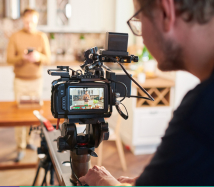Educational videos have become a powerful tool for marketers, ed tech companies, and business professionals. These videos can effectively convey complex information, engage learners, and enhance learning experiences. But when it comes to producing educational videos, one critical decision stands out: should you use a voiceover/narration-based approach, or be present on camera, talking to your audience directly? This article compares these two approaches, providing valuable insights to help you determine the best method for your educational video.
Understanding Voiceover and On-Camera Presentation
Voiceovers
Voiceovers involve narrating the content of the video without the narrator appearing on screen. This technique is commonly used in explainer videos, tutorials, and e-learning courses. Effective voiceover videos often feature clear, professional narration synchronized with relevant visuals, such as animations, slides, or live-action footage.
Watch the educational video from the Next Generation Science featuring a clear voiceover that explains the alternation between day and night.
On-Camera Presentation
In an on-camera presentation, the presenter appears on screen, directly addressing the audience. This method is often used in webinars, instructional videos, and lectures. On-camera presentations typically involve a presenter speaking to the camera, sometimes accompanied by visual aids or demonstrations.
The educational video from the Miacademy Learning channel is an excellent example of an on-camera presentation. The presenter explains the ‘Layers of the Atmosphere’ with detailed animated clips interspersed throughout.
Advantages of Voiceovers
Flexibility in Production
Voiceovers are easier to record and edit compared to on-camera presentations. Changes can be made to the script and narration without reshooting video footage.
Voiceovers can be produced remotely, allowing for greater flexibility in terms of location and scheduling.
Cost-Effectiveness
Producing an educational video with a voiceover only is often cheaper as it requires less equipment and setup compared to on-camera presentations.
There are no expenses related to the presenter’s appearance, such as wardrobe, makeup, or travel.
Focus on Content
Voiceovers allow for better integration with animations, graphics, and other visual elements, keeping the student’s attention on the learning content.
This minimizes distractions that can occur with on-camera presentations. On-camera presentations can distract viewers with the presenter’s appearance, voice, personality, background elements and excessive gestures, potentially diverting attention from the educational content. These distractors are not there in educational videos with voiceover ensuring that the focus remains on the content.
Check out this engaging number learning video for kids by Tini-Toys & Toddlers. The animated educational video features a clear voiceover and captivating visual elements, designed to help children better focus on the content.
Need a Company Profile Video, An Explainer Video, or a Product Shoot?
Whatever kind of video you need, we’ll get it done.

Advantages of On-Camera Presentation
Personal Connection
On-camera presentations build a rapport with the audience, making the content feel more personal and relatable.
Seeing a human face can enhance emotional connection and engagement with the learning material.
Engagement
Visual cues and body language from the presenter can enhance understanding and retention of information.
On-camera presenters can use gestures and expressions to emphasize key points, making the content more engaging.
Credibility and Trust
A presenter can increase the perceived authority and trustworthiness of the information being shared through the video.
On-camera presentations can help establish the presenter as an expert in the field, adding credibility to the content.
Watch this educational video produced by Indievisual, a video production company, for DSP Mutual Fund. The video features an on-camera presenter who explains the concept of the BEER Ratio to add authority, trust, and credibility to the content.
Factors to Consider When Choosing Between Voiceover and On-Camera Presentation
Target Audience
Consider the preferences and expectations of your audience. Some audiences may prefer the personal touch of an on-camera presenter, while others may appreciate the clarity and focus of a voiceover.
Watch this educational video from Harvard University’s ‘Harvard Natural Sciences Lecture Demonstrations,’ where a professor demonstrates the ‘Coanda Effect.’ The institution selected a professor as the on-camera presenter to provide a personal touch, just like a teacher instructing students, who are the target audience.
Content Type
The complexity and nature of the material can influence your choice. Highly detailed or technical content might benefit from voiceovers paired with visual aids, while more motivational or persuasive content might be better suited to on-camera presentation.
Watch this educational video from Simplilearn that explains the complex concept of cybersecurity. The ed-tech company uses a voiceover with animations to effectively convey the topic.
Budget and Resources
Evaluate your available budget and production capabilities. Voiceovers can be more cost-effective and easier to produce, while on-camera presentations may require more investment in terms of equipment and preparation.
Brand Identity
Consider how each method aligns with your brand’s image and message. On-camera presentations can humanize your brand, while voiceovers can maintain a polished, professional tone.
Practical Tips for Creating Effective Educational Videos
For Voiceovers
- Choosing the Right Voice Talent: Select a narrator with a clear, engaging voice that matches the tone of your content.
- Scripting and Pacing: Write a concise, well-structured script and practice pacing to ensure clarity and retention.
- Integrating Visuals Effectively: Use animations, graphics, and other visuals to complement the narration and enhance understanding.
For On-Camera
- Preparing the Presenter: Ensure the presenter is well-prepared, confident, and comfortable in front of the camera.
- Setting Up the Shot: Pay attention to lighting, background, and camera angles to create a professional appearance.
- Engaging with the Audience: Encourage the presenter to make eye contact with the camera, use natural gestures, and maintain a conversational tone.
Choosing between voiceovers and on-camera presentation for your educational video depends on various factors, including your target audience, content type, budget, and brand identity. Both methods have unique advantages and can be highly effective when used appropriately. By understanding the strengths of each approach and considering your specific needs, you can create engaging educational videos that resonate with your audience and achieve your objectives.








